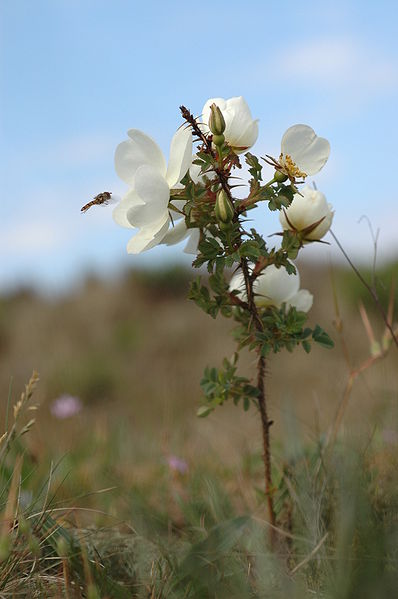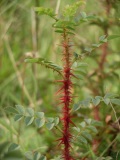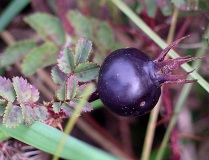- Home
- >
- Seeds of Shrubs and Climbers A-Z by Latin Name
- >
- Scotch or Burnet Rose (rosa spinosissima)
Scotch or Burnet Rose (rosa spinosissima)
SKU:
£1.10
1.1
10.5
£1.10 - £10.50
Unavailable
per item
Seed Prices
1 gram (approx 39 seeds) £1.10
2 grams(approx 78 seeds) £1.65
5 grams (approx 195 seeds) £2.25
10 grams (approx 390 seeds) £3.50
25 grams (approx 975 seeds) £6.75
50 grams (approx 1950 seeds) £10.50
Use the drop down button below to select the seed quantity
Germination, Sowing and After Care Information for
Scotch/Burnet Rose (rosa pimpinellifolia)
Scotch/Burnet Rose seeds have a deep dormancy within them, this requires a degree of patience to overcome and it is usually quite easy to get high levels of germination if the correct procedures are followed.
First prepare a free draining substrate into which the seeds are to be mixed, this can be a 50/50 mixture of compost and sharp sand, or perlite, vermiculite. The chosen substrate needs to be moist (but not wet), if you can squeeze water out of it with your hand it is too wet and your seeds may drown and die.
the seeds into the substrate, making sure that their is enough volume of material to keep the seeds separated. Place the seed mixture into a clear plastic bag (freezer bags, especially zip-lock bags are very useful for this -provided a little gap is left in the seal for air exchange) If it is not a zip-lock type bag it needs to be loosely tied.
Write the date on the bag so that you know when the pre-treatment was started.
The seeds first require a period of warm pre-treatment and need to be kept in temperatures of 20 Celsius (68F) for a period of at least 12 weeks . During this time make sure that the pre-treatment medium does not dry out at any stage or it will be ineffective!
Next the seeds require a cold period to break the final part of the dormancy, this is easily achieved by placing the bag in the fridge at (4 Celsius or 39F) for at least 14 weeks (although it can take as many as 18 weeks for signs of germination to show). It is quite possible for the seeds to germinate in the bag at these temperatures when they are ready to do so, if they do, just remove them from the bag and carefully plant them up.
When the period of pre-treatment has finished the seed should be ready to be planted. Small quantities can be sown in pots or seed trays filled with a good quality compost and cover them with a thin layer of compost no more than 1 cm deep. For larger quantities it is easiest to sow the seeds in a well prepared seedbed outdoors once the warm and cold pre-treatments have finished and wait for the seedlings to appear.
It has also been found that fluctuating pre-treatment temperatures can give the best germination results and I have myself had excellent results by keeping the mixed seeds in a cold shed through the winter for the cold stage of their pre-treatment and allowing the temperature to fluctuate naturally. Ungerminated seeds can have the whole warm and cold process repeated again to enable more seeds to germinate. Fresh seedlings can keep germinating for up to 5 years after the original sowing date.
Do not expose newly sown seeds to high temperatures (above 25 Celsius). Keep the seedlings well watered and weed free.
Growth in the first year is usually between 20 and 40 cm depending on the time of germination and cultural techniques and developing seedlings are usually trouble free. Allow them to grow for 2 years before planting them in a permanent position.
First prepare a free draining substrate into which the seeds are to be mixed, this can be a 50/50 mixture of compost and sharp sand, or perlite, vermiculite. The chosen substrate needs to be moist (but not wet), if you can squeeze water out of it with your hand it is too wet and your seeds may drown and die.
the seeds into the substrate, making sure that their is enough volume of material to keep the seeds separated. Place the seed mixture into a clear plastic bag (freezer bags, especially zip-lock bags are very useful for this -provided a little gap is left in the seal for air exchange) If it is not a zip-lock type bag it needs to be loosely tied.
Write the date on the bag so that you know when the pre-treatment was started.
The seeds first require a period of warm pre-treatment and need to be kept in temperatures of 20 Celsius (68F) for a period of at least 12 weeks . During this time make sure that the pre-treatment medium does not dry out at any stage or it will be ineffective!
Next the seeds require a cold period to break the final part of the dormancy, this is easily achieved by placing the bag in the fridge at (4 Celsius or 39F) for at least 14 weeks (although it can take as many as 18 weeks for signs of germination to show). It is quite possible for the seeds to germinate in the bag at these temperatures when they are ready to do so, if they do, just remove them from the bag and carefully plant them up.
When the period of pre-treatment has finished the seed should be ready to be planted. Small quantities can be sown in pots or seed trays filled with a good quality compost and cover them with a thin layer of compost no more than 1 cm deep. For larger quantities it is easiest to sow the seeds in a well prepared seedbed outdoors once the warm and cold pre-treatments have finished and wait for the seedlings to appear.
It has also been found that fluctuating pre-treatment temperatures can give the best germination results and I have myself had excellent results by keeping the mixed seeds in a cold shed through the winter for the cold stage of their pre-treatment and allowing the temperature to fluctuate naturally. Ungerminated seeds can have the whole warm and cold process repeated again to enable more seeds to germinate. Fresh seedlings can keep germinating for up to 5 years after the original sowing date.
Do not expose newly sown seeds to high temperatures (above 25 Celsius). Keep the seedlings well watered and weed free.
Growth in the first year is usually between 20 and 40 cm depending on the time of germination and cultural techniques and developing seedlings are usually trouble free. Allow them to grow for 2 years before planting them in a permanent position.






